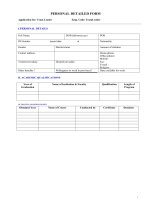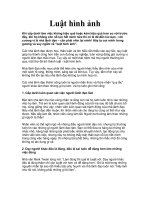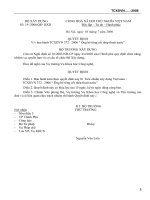Tài liệu Market Power: Monopoly ppt
Bạn đang xem bản rút gọn của tài liệu. Xem và tải ngay bản đầy đủ của tài liệu tại đây (197.03 KB, 25 trang )
Chapter 10
Market Power:
Monopoly
Chapter 10
Slide 2
Topics to be Discussed
Monopoly
Monopoly Power
Sources of Monopoly Power
The Social Costs of Monopoly Power
Chapter 10
Slide 3
Perfect Competition
Review of Perfect Competition
z P = LMC = LRAC
z Normal profits or zero economic profits in
the long run
z Large number of buyers and sellers
z Homogenous product
z Perfect information
z Firm is a price taker
Perfect Competition
Q
Q
PP
Market Individual Firm
DS
Q
0
P
0
P
0
D = MR = P
q
0
LRACLMC
Chapter 10
Slide 5
Monopoly
Monopoly
1) One seller - many buyers
2) One product (no good substitutes)
3) Barriers to entry
Chapter 10
Slide 6
Sources of Monopoly Power
Why do some firm’s have considerable
monopoly power, and others have little
or none?
A firm’s monopoly power is determined
by the firm’s elasticity of demand.
Chapter 10
Slide 7
Sources of Monopoly Power
The firm’s elasticity of demand is
determined by:
1) Elasticity of market demand
2) Number of firms
3) The interaction among firms
Chapter 10
Slide 8
Monopoly
The monopolist is the supply-side of the
market and has complete control over
the amount offered for sale.
Profits will be maximized at the level of
output where marginal revenue equals
marginal cost.
Chapter 10
Slide 9
Monopoly
Finding Marginal Revenue
z As the sole producer, the monopolist works
with the market demand to determine
output and price.
z Assume a firm with demand:
P = 6 - Q
Chapter 10
Slide 10
Total, Marginal, and Average Revenue
$6 0 $0
51 5$5$5
42 83 4
33 91 3
24 8-1 2
15 5-3 1
Total Marginal Average
Price Quantity Revenue Revenue Revenue
PQ RMRAR
Chapter 10
Slide 11
Average and Marginal Revenue
Output
0
1
2
3
$ per
unit of
output
1234567
4
5
6
7
Average Revenue (Demand)
Marginal
Revenue
Chapter 10
Slide 12
Monopoly
Observations
1) To increase sales the price must fall
2) MR < P
3) Compared to perfect competition
No change in price to change sales
MR = P
Chapter 10
Slide 13
Monopoly
Monopolist’s Output Decision
1) Profits maximized at the output level
where MR = MC
2) Cost functions are the same
MRMCor
MRMCQCQRQ
QCQRQ
=
−==∆∆−∆∆=∆∆
−
=
0///
)()()(
π
π
Chapter 10
Slide 14
Maximizing Profit When Marginal
Revenue Equals Marginal Cost
At output levels below MR = MC the
decrease in revenue is greater than the
decrease in cost (MR > MC).
At output levels above MR = MC the
increase in cost is greater than the
decrease in revenue (MR < MC)
The Monopolist’s Output Decision
Chapter 10
Slide 15
Lost
profit
P
1
Q
1
Lost
profit
MC
AC
Quantity
$ per
unit of
output
D = AR
MR
P*
Q*
Maximizing Profit When Marginal
Revenue Equals Marginal Cost
P
2
Q
2
Chapter 10
Slide 16
Monopoly
An Example
Q
Q
C
MC
QQCCost
2
50)(
2
=
∆
∆
=
+==
The Monopolist’s Output Decision
Chapter 10
Slide 17
Monopoly
An Example
Q
Q
R
MR
QQQQPQR
P
Demand
240
40)()(
40)(
2
−=
∆
∆
=
−==
−
=
=
The Monopolist’s Output Decision
Chapter 10
Slide 18
Monopoly
An Example
30 10,When
10
2240
==
=
=
−
=
P Q
Q
QQorMCMR
The Monopolist’s Output Decision
Chapter 10
Slide 19
Monopoly
An Example
z By setting marginal revenue equal to
marginal cost, it can be verified that profit is
maximized at P = $30 and Q = 10.
z This can be seen graphically:
The Monopolist’s Output Decision
Chapter 10
Slide 20
Monopoly
A Rule of Thumb for Pricing
z We want to translate the condition that
marginal revenue should equal marginal
cost into a rule of thumb that can be more
easily applied in practice.
z This can be demonstrated using the
following steps:
Chapter 10
Slide 21
A Rule of Thumb for Pricing
∆
∆
=
∆
∆
+=
∆
∆
+=
∆
∆
=
∆
∆
=
P
Q
Q
P
E
Q
P
P
Q
PP
Q
P
QPMR
Q
PQ
Q
R
MR
d
.3
.2
)(
.1
Chapter 10
Slide 22
A Rule of Thumb for Pricing
+=
=
∆
∆
d
d
E
PPMR
E
Q
P
P
Q
1
.5
1
.4
Chapter 10
Slide 23
A Rule of Thumb for Pricing
()
D
DD
E11
MC
P
EE
1
P P
MCMR@maximized is
+
=
−=
+
=
1
.6
π
Chapter 10
Slide 24
= the markup over MC as a
percentage of price (P-MC)/P
d
E
1
.7 −
A Rule of Thumb for Pricing
8. The markup should equal the
inverse of the elasticity of demand.
Chapter 10
Slide 25
A Rule of Thumb for Pricing
()
12$
75.
9
4
1
1
9
94
1
1
9
==
−
+
=
=−=
+
=
.
P
MCE
Assume
E
MC
P
d
d
Chapter 10
Slide 26
Monopoly
Monopoly pricing compared to perfect
competition pricing:
z Monopoly
P > MC
z Perfect Competition
P = MC
Chapter 10
Slide 27
Monopoly
Monopoly pricing compared to perfect
competition pricing:
z The more elastic the demand the closer
price is to marginal cost.
z If E
d
is a large negative number, price is
close to marginal cost and vice versa.
Chapter 10
Slide 28
Monopoly
Shifts in Demand
z In perfect competition, the market supply
curve is determined by marginal cost.
z For a monopoly, output is determined by
marginal cost and the shape of the
demand curve.
Chapter 10
Slide 29
Demand shifts
Q
$/Q
B
A
MR
1
MC
MR
2
D
1
D
2
Demand goes up
- Price increases
- Quantity
increases
Chapter 10
Slide 30
MC shifts
Q
$/Q
B
A
MC
1
MR
D
2
MC lower
- Price decreases
- Quantity increases
- Part of the benefits is
transferred to consumers
MC
2
Chapter 10
Slide 31
Monopoly
Observations
z Shifts in demand usually cause a change
in both price and quantity.
z A monopolistic market has no supply
curve.
Chapter 10
Slide 32
Monopoly
Observations
z Monopolist may supply many different
quantities at the same price.
z Monopolist may supply the same quantity
at different prices.
Chapter 10
Slide 33
Monopoly
Algebraically:
21
2
1
MCMCMR
MCMR
MCMR
==
=
−
Chapter 10
Slide 34
Monopoly Power
Monopoly is rare.
However, a market with several firms,
each facing a downward sloping
demand curve will produce so that price
exceeds marginal cost.
Chapter 10
Slide 35
Monopoly Power
Measuring Monopoly Power
z In perfect competition: P = MR = MC
z Monopoly power: P > MC
Chapter 10
Slide 36
Monopoly Power
Lerner’s Index of Monopoly Power
z L = (P - MC)/P
The larger the value of L (between 0 and
1) the greater the monopoly power.
z L is expressed in terms of E
d
L = (P - MC)/P = -1/E
d
E
d
is elasticity of demand for a firm, not
the market
Chapter 10
Slide 37
Monopoly Power
Monopoly power does not guarantee
profits.
Profit depends on average cost relative
to price.
Question:
z Can you identify any difficulties in using the
Lerner Index (L) for public policy?
Chapter 10
Slide 38
Monopoly Power
The Rule of Thumb for Pricing
z Pricing for any firm with monopoly power
If E
d
is large, markup is small
If E
d
is small, markup is large
()
d
E
MC
P
11+
=
Elasticity of Demand and Price Markup
$/Q $/Q
Quantity Quantity
AR
MR
MR
AR
MC MC
Q* Q*
P*
P*
P*-MC
The more elastic is
demand, the less the
markup.
Chapter 10
Slide 40
The Social Costs of Monopoly Power
Monopoly power results in higher prices
and lower quantities.
However, does monopoly power make
consumers and producers in the
aggregate better or worse off?
Chapter 10
Slide 41
B
A
Lost Consumer Surplus
Deadweight
Loss
Because of the higher
price, consumers lose
A+B and producer
gains A-C.
C
Deadweight Loss from Monopoly Power
Quantity
AR
MR
MC
Q
C
P
C
P
m
Q
m
$/Q
Chapter 10
Slide 42
Rent Seeking
z Firms may spend to gain monopoly power
Lobbying
Advertising
Building excess capacity
The Social Costs of Monopoly Power
Chapter 10
Slide 43
The incentive to engage in monopoly
practices is determined by the profit to
be gained.
The larger the transfer from consumers
to the firm, the larger the social cost of
monopoly.
The Social Costs of Monopoly Power
Chapter 10
Slide 44
Price Regulation
z Recall that in competitive markets, price
regulation created a deadweight loss.
Question:
z What about a monopoly?
The Social Costs of Monopoly Power
Chapter 10
Slide 45
Natural Monopoly
z A firm that can produce the entire output of
an industry at a cost lower than what it
would be if there were several firms.
The Social Costs of Monopoly Power
Chapter 10
Slide 46
MC
AC
AR
MR
$/Q
Quantity
Setting the price at P
r
yields the largest possible
output;excess profit is zero.
Q
r
P
r
P
C
Q
C
If the price were regulate to be P
C
,
the firm would lose money
and go out of business.
P
m
Q
m
Unregulated, the monopolist
would produce Q
m
and
charge P
m
.
Regulating the Price
of a Natural Monopoly
Chapter 10
Slide 47
Regulation in Practice
z It is very difficult to estimate the firm's cost
and demand functions because they
change with evolving market conditions
The Social Costs of Monopoly Power
Chapter 10
Slide 48
Regulation in Practice
z An alternative pricing technique rate-of-
return regulation allows the firms to set a
maximum price based on the expected rate
or return that the firm will earn.
P = AVC + (D + T + sK)/Q, where
z P = price, AVC = average variable cost
z D = depreciation, T = taxes
z s = allowed rate of return, K = firm’s capital
stock
The Social Costs of Monopoly Power
Chapter 10
Slide 49
Regulation in Practice
z Using this technique requires hearings to
arrive at the respective figures.
z The hearing process creates a regulatory
lag that may benefit producers (1950s &
60s) or consumers (1970s & 80s).
Question
z Who is benefiting in the 1990s?
The Social Costs of Monopoly Power
Chapter 10
Slide 50
Vietnam Competition Law
Dr. Le Dang Doanh asserted that anti-
monopoly in Vietnam is more complicated
compared to other countries, because firms
gain their monopolistic power not through
competing, but by the support of the
government. He said: “The law create a legal
framework for anti-monopoly and abuse of
market dominant position, how effective that
anti-dumping can go depends on whether
state agencies want to attack the firms that
they have been supporting or not”









